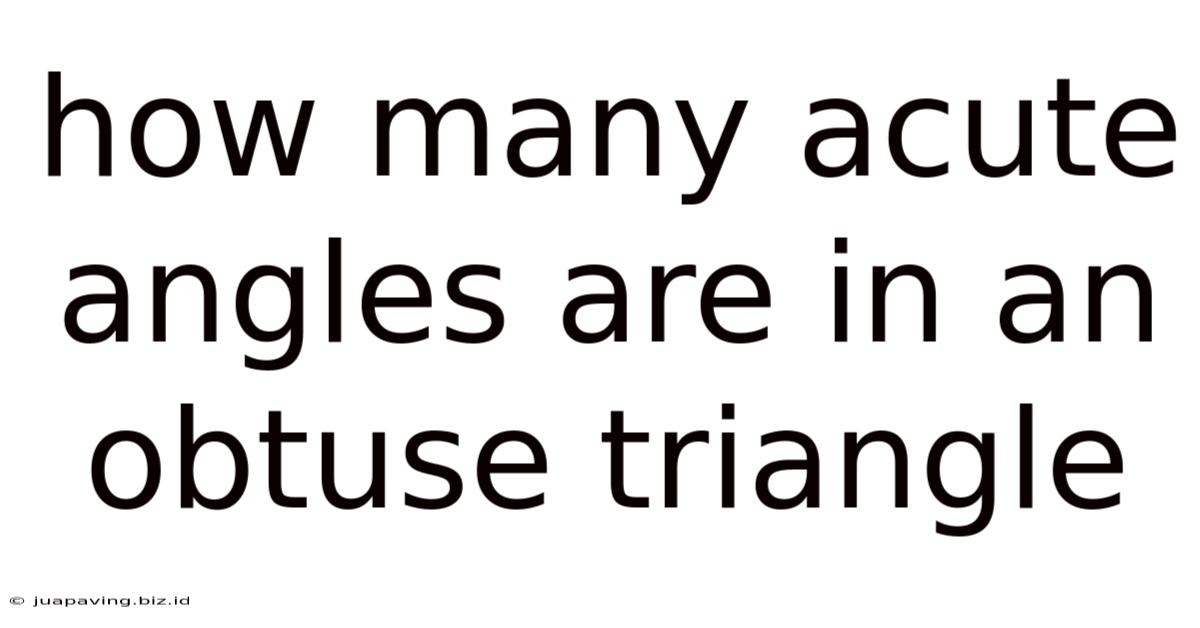How Many Acute Angles Are In An Obtuse Triangle
Juapaving
May 13, 2025 · 4 min read

Table of Contents
How Many Acute Angles are in an Obtuse Triangle?
The question of how many acute angles are in an obtuse triangle might seem deceptively simple, but understanding the answer requires a firm grasp of fundamental geometric principles. This article delves into the definition of triangles, explores the properties of acute, obtuse, and right angles, and finally answers the central question definitively. We'll also explore related concepts to solidify your understanding of triangle geometry.
Understanding Triangles and Their Angles
A triangle is a closed two-dimensional geometric shape defined by three sides and three angles. The sum of the interior angles of any triangle always equals 180 degrees. This is a fundamental theorem in geometry and forms the basis for much of our analysis.
Triangles are classified based on their angles:
- Acute Triangle: A triangle with three acute angles (angles measuring less than 90 degrees).
- Obtuse Triangle: A triangle with one obtuse angle (an angle measuring greater than 90 degrees) and two acute angles.
- Right Triangle: A triangle with one right angle (an angle measuring exactly 90 degrees) and two acute angles.
Defining Acute and Obtuse Angles
Before we proceed, let's clearly define the types of angles involved:
- Acute Angle: An angle whose measure is less than 90 degrees.
- Obtuse Angle: An angle whose measure is greater than 90 degrees and less than 180 degrees.
- Right Angle: An angle whose measure is exactly 90 degrees.
The Crucial Relationship in Obtuse Triangles
The key to understanding the number of acute angles in an obtuse triangle lies in the 180-degree sum of interior angles. Since an obtuse triangle has one angle greater than 90 degrees, the remaining two angles must be less than 90 degrees to maintain the total sum of 180 degrees.
Let's illustrate with an example:
Suppose an obtuse triangle has one angle measuring 100 degrees. The sum of the other two angles must be 180 - 100 = 80 degrees. If one of these remaining angles were 90 degrees or greater, the total sum would exceed 180 degrees, violating the fundamental theorem of triangles. Therefore, both remaining angles must be acute angles (less than 90 degrees).
The Answer: Two Acute Angles
Therefore, the definitive answer to the question is: An obtuse triangle always has exactly two acute angles. This is a direct consequence of the fixed sum of interior angles in a triangle and the definition of an obtuse angle.
Exploring Further: Visualizing Obtuse Triangles
To enhance your understanding, consider visualizing different obtuse triangles. Draw several triangles with varying obtuse angles. In each case, measure the remaining two angles; you'll consistently find them to be acute. This hands-on approach strengthens the concept and confirms the mathematical principle.
Related Geometric Concepts
Understanding the properties of obtuse triangles opens the door to exploring related concepts within geometry:
- Isosceles Triangles: An obtuse triangle can also be an isosceles triangle (two sides of equal length). The acute angles in an obtuse isosceles triangle will be equal.
- Scalene Triangles: An obtuse triangle can also be a scalene triangle (all three sides have different lengths). In this case, the two acute angles will have different measures.
- Exterior Angles: The exterior angles of a triangle (the angles formed by extending one side of the triangle) have a relationship with the interior angles. Understanding exterior angles further reinforces the concepts of angles and their sums.
- Triangle Inequality Theorem: This theorem states that the sum of the lengths of any two sides of a triangle must be greater than the length of the third side. This is a fundamental principle in triangle geometry and relates to the feasibility of constructing triangles with specific side lengths.
Practical Applications
Understanding the properties of triangles, including obtuse triangles and their angles, has practical applications in various fields:
- Architecture and Construction: Understanding angles is critical for building stable and structurally sound structures.
- Engineering: Many engineering designs rely on precise geometric calculations, including the properties of triangles.
- Computer Graphics and Game Development: Accurate representation of shapes and objects in computer graphics heavily relies on geometric principles.
- Cartography and Surveying: Measuring and calculating angles is crucial for accurate mapmaking and land surveying.
- Navigation: Understanding angles is fundamental for navigation and determining distances and directions.
Conclusion
The number of acute angles in an obtuse triangle is always two. This seemingly simple question leads to a deeper understanding of fundamental geometric principles, including the sum of interior angles and the properties of different types of triangles. By exploring related concepts and visualizing examples, you can solidify your grasp of triangle geometry and its wide-ranging applications. The seemingly simple question of acute angles in an obtuse triangle serves as a gateway to a richer understanding of geometric relationships and their importance in various fields. Remember to continue exploring and practicing geometry to further enhance your knowledge and problem-solving abilities.
Latest Posts
Latest Posts
-
Nouns That Start With An R
May 14, 2025
-
How To Start An Informal Letter
May 14, 2025
-
Particle Theory Of Matter 5 Points
May 14, 2025
-
5 Letter Words Starting With P A R
May 14, 2025
-
What Organelles Are Only In Plant Cells
May 14, 2025
Related Post
Thank you for visiting our website which covers about How Many Acute Angles Are In An Obtuse Triangle . We hope the information provided has been useful to you. Feel free to contact us if you have any questions or need further assistance. See you next time and don't miss to bookmark.